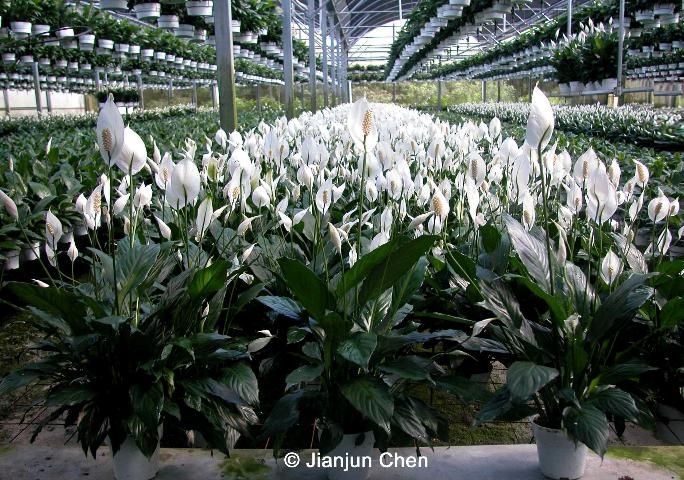Cultural Guidelines for Commercial Production of Interiorscape Spathiphyllum
Spathiphyllum literally translates into "leaf spathe." It is commonly called Peace Lily, Snowflower, Spathe Flower, or White Anthurium. Spathiphyllum belongs to the family Araceae, has about 41 species, and originates from Panama, Columbia, Ecuador, Venezuela, the Malay Archipelago, Costa Rica, and the Philippines where it thrives in humid, tropical rainforest understories.
Peace Lily is an herbaceous evergreen with short, erect to creeping stems bearing tufts of foliage. Leaves are dark green and ovate to lanceolate. The inflorescence is a white, hood-shaped spathe sheltering a cream/white spadix covered with bisexual flowers. From an ornamental viewpoint, the spathes and spadices are called flowers rather than the tiny true flowers on the spadix. Inflorescences are produced seasonally or intermittently and can also be induced with chemical sprays.

Spathiphyllum cultivars are popular interiorscape plants in part because of the wide selection of cultivars ranging in height from 12 inches to 4 feet. Also, they are easy to care for and they are attractive plants, with dark green foliage contrasting with lily-white flowers. They can be grown in a variety of pot sizes and hold up extremely well in interiorscapes. NASA even praised them in the Clean Air Study for their ability to remove formaldehyde, benzene, and carbon monoxide from interior air.
The intent of this article is to describe common cultivars in the foliage plant industry (See Table 1), provide guidelines for their culture and interior use, and list physiological problems that may be encountered during production and interiorscape use (See Table 3).
Cultural Guidelines
Propagation
Propagation can be accomplished through division, tissue culture, or seed germination. Basal shoots can be separated from mother plants and potted in container substrates. Tissue culture is now the most common propagation method. Plantlets from tissue culture are grown in medium-filled, multi-cavity plastic liner trays. Liners are then planted into larger containers. Spathiphyllum 'Cupido' is exclusively propagated from seed in production.
Production
Peace Lily requires container substrates possessing high water and nutrient holding capacities. Canadian peat at 50 to 60% in volume is often combined with pine bark, vermiculate, or coir as the container substrate for Spathiphyllum production. When using the pour-through method to extract root-zone solution, substrates should have an initial pH range of 1.0 to 2.0, during cooler periods. Plants should be grown under 1500-2500 fc, which is about 75% shade in winter and 80% in summer in Florida. Excessive light bleaches leaves and the resulting pale color is often misidentified as a nutrient deficiency.
Fertilizer rates vary according to temperature, 3-1-2 N:P2O5:K2O at 3.0 lb. N per 1,000 square feet per month during warmer growing season and 2.5 lbs N per 1,000 square feet during the cooler season. If foliar sprays are used, they are best applied to the underside of the leaf since the upper side is waxy, and the spray will leave a gray residue. Growers are recommended to monitor media soluble salts and pH every 2 or 3 weeks using the pour-through method. Information regarding the pour-through method can be found at https://edis.ifas.ufl.edu/pdffiles/EP/EP07400.pdf. If the soluble salts reading is 1 dS/m, the plant will show nutrient deficiency if no fertilizer is provided during the growing season; if the soluble salts reading is 2 dS/m, nutrient levels are adequate; and if the reading is 3 dS/m or above, reduce either the rate or the frequency of fertilizer application. Table 2 provides a guide for determining if Spathiphyllum cultivars are appropriately fertilized based on leaf analysis. Spathiphyllum has rather thin but abundant leaves; keep container substrates moist during periods when temperatures exceed 80°F.
A general consensus among growers is that Spathiphyllum is more cold tolerant than other aroids. Our studies showed that exposure to 45°F could cause chilling injury in some cultivars, and delayed or reduced growth occurred when plants were exposed to 52°F for five days. Detailed information of Spathiphyllum responses to chilling temperatures can be found at https://edis.ifas.ufl.edu/ep101. The preferred temperature range for Peace Lily production is 70-90°F.
The market value of Spathiphyllum depends heavily on the presence of flowers. Most Spathiphyllum cultivars only flower from January to August. In order to have a year-round flowering, a foliar spray of gibberellic acid (GA3, Pro-Gibb) at a concentration of 250 ppm has been widely used in flower induction. Our recent studies indicate that a one-time foliar spray of GA3 at a concentration of 100 ppm can not only effectively induce flowering but also improve flower quality. Depending on cultivars, flowers will appear in 9 to 12 weeks after GA3 spray. Thus, growers can program flowering time and optimal shipping dates with GA3 sprays.
Shipping and Interior Care
Use sleeves when shipping to avoid damage to the thin leaves. Shipping temperatures can range from 55 to 60°F. Once placed in interior conditions, individual blooms may last for a month or so. Trim dead blooms and leaves as soon as possible. Avoid over-fertilizing, as high soluble salts will burn leaf tips and margins. Using a 20-20-20 water soluble fertilizer solution with a N level at 50 ppm once a month or maintaining a soluble salts range of 0.8 to 1.2 dS/m should be adequate under interior conditions. The most common problem is underwatering which causes the entire plant to severely wilt or, as it is known in the trade, "crash."
Another maintenance problem with Spathiphyllum is a tendency to accumulate dust on their leaves. Wipe with a damp cloth to remove dust and the occasional pest. An occasional light spray of leaf polish is also recommended to reduce dust accumulation.


